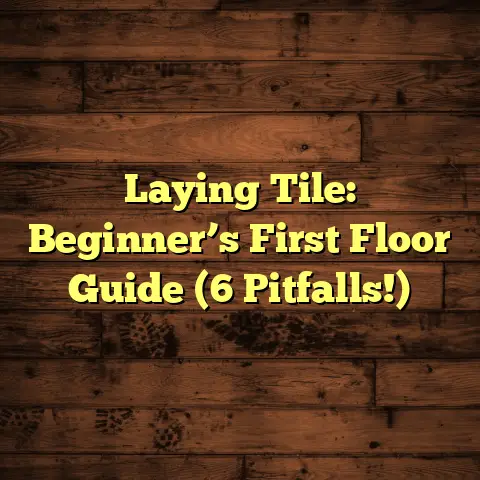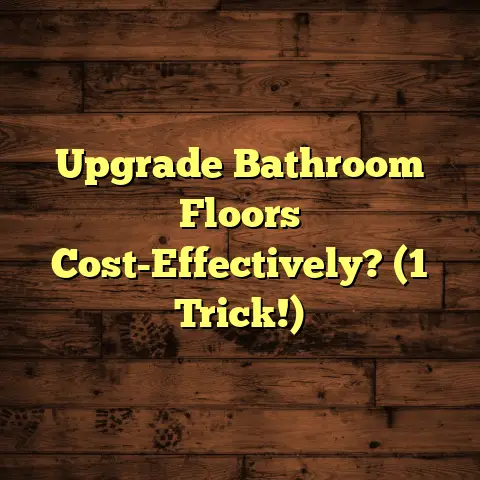Laminate Sticky Residue Removal? (4 Fixes NOW!)
I’m a flooring contractor, and let me tell you, I’ve seen it all when it comes to flooring mishaps.
One thing I hear about constantly is sticky residue on laminate floors.
Laminate flooring is fantastic, isn’t it?
It’s a popular choice because it’s cost-effective and relatively easy to install yourself.
I mean, you can really transform a room in a weekend!
But, like any flooring, it’s not immune to problems.
Sticky residue is a common issue, and it can be a real pain.
It can come from spills, adhesive, or even cleaning products.
The key is to tackle it quickly to keep your floors looking great and prevent any long-term damage.
So, let’s dive into some tried-and-true methods I use to get rid of that pesky stickiness!
Section 1: Understanding Laminate Flooring and Sticky Residue
First off, let’s talk about what laminate flooring actually is.
It’s basically a multi-layer synthetic flooring product fused together with a lamination process.
The inner core is usually made of fiberboard or particleboard, and the top layer is a printed decorative layer protected by a clear wear layer.
This wear layer is what gives laminate its durability, but it’s also what can get sticky!
You’ll find laminate in homes and businesses because it’s durable and mimics the look of hardwood, tile, or stone.
Now, what exactly is sticky residue?
It’s any substance that clings to the surface of your floor, making it feel tacky or gummy.
It’s not just unsightly; it can also attract dirt and make your floors even harder to clean.
Over time, sticky residue can dull the finish and even damage the wear layer of your laminate.
Believe me, I’ve seen floors that were ruined because the sticky residue was left untreated for too long.
So, what causes this sticky menace?
Here are some common culprits I’ve encountered over the years:
-
Glue from installation: Sometimes, adhesive can seep up between the seams, especially if too much was used during installation.
-
Spilled food or drinks: Sugary drinks, syrups, and sauces can leave behind a sticky mess if not cleaned up immediately.
-
Cleaning products: Using the wrong cleaning products, or using too much soap, can leave a film that attracts dirt and becomes sticky.
-
Improper maintenance: Not cleaning your floors regularly can allow dirt and grime to build up, creating a sticky layer over time.
Section 2: Fix 1 – Vinegar and Water Solution
Okay, let’s get to the good stuff – how to actually fix this problem!
My go-to solution for light sticky residue is a simple vinegar and water mix.
It’s cheap, effective, and you probably already have the ingredients in your kitchen!
Here’s the recipe I recommend:
- 1 cup of white vinegar
- 1 gallon of warm water
Mix the vinegar and water in a bucket.
That’s it!
Why does this work?
Well, vinegar is a mild acid that helps break down sticky substances.
The acetic acid in vinegar is a natural solvent that can dissolve grease, grime, and other sticky residues.
Plus, it’s a natural disinfectant, so it helps kill germs too.
Here’s how to apply the solution:
Test in a small area: Before you go all-in, test the solution on an inconspicuous area of your floor to make sure it doesn’t damage the finish.
I usually test in a closet or under a piece of furniture.Mop the floor: Dip a clean mop into the vinegar and water solution, making sure to wring out the excess water.
You don’t want to soak your laminate floor!-
Mop in sections: Work in small sections, mopping with even strokes.
-
Rinse with clean water: After mopping with the vinegar solution, go over the floor again with a clean mop and plain water to remove any remaining vinegar.
Dry the floor: Use a clean, dry towel or microfiber cloth to dry the floor thoroughly.
This is important to prevent water spots and potential damage.
Pro Tip: I always recommend using a microfiber mop for laminate floors.
They’re super absorbent and won’t scratch the surface.
Also, make sure to change your mop head frequently to avoid spreading dirt around.
Section 3: Fix 2 – Baking Soda Paste
If the vinegar solution isn’t cutting it, it’s time to bring out the baking soda!
Baking soda is a mild abrasive that can help lift sticky substances without damaging your laminate.
Here’s how to make a baking soda paste:
- 1/4 cup baking soda
- Enough water to form a paste
Mix the baking soda and water in a small bowl until you have a thick paste.
It should be spreadable but not too runny.
Baking soda works because it’s a gentle abrasive.
It can scrub away sticky residue without scratching the surface of your laminate, unlike harsher abrasives.
Here’s how to apply the paste:
-
Apply to affected area: Use a soft cloth or sponge to apply the baking soda paste to the sticky area.
-
Let it sit: Let the paste sit for 5-10 minutes to allow it to loosen the residue.
Gently scrub: Using a soft cloth or sponge, gently scrub the area in a circular motion.
Avoid using too much pressure, as this could damage the laminate.-
Rinse with clean water: Rinse the area thoroughly with clean water to remove all traces of the baking soda paste.
-
Dry the area: Use a clean, dry towel to dry the area completely.
Important Note: Make sure to remove all traces of the baking soda paste.
If left behind, it can dry and leave a white residue.
I always double-check to make sure I’ve rinsed everything properly.
Section 4: Fix 3 – Commercial Adhesive Remover
Sometimes, you’re dealing with serious sticky residue – like glue from installation or stubborn adhesives.
In these cases, a commercial adhesive remover might be necessary.
There are tons of adhesive removers on the market, so it’s important to choose one that’s safe for laminate flooring.
Look for products that are specifically designed for use on delicate surfaces and are non-abrasive.
I’ve had good luck with brands like Goo Gone and Krud Kutter, but always read the label carefully before using any product.
Some adhesive removers are eco-friendly, which is a great option if you’re concerned about harsh chemicals.
These typically use natural ingredients like citrus oils to dissolve adhesives.
Here’s how to use commercial adhesive removers safely:
-
Read the label: Always read the manufacturer’s instructions carefully before using any adhesive remover.
Ventilation: Make sure the area is well-ventilated.
Open windows and doors to allow fresh air to circulate.-
Test in an inconspicuous area: As with any cleaning product, test the adhesive remover on a small, inconspicuous area of your floor to make sure it doesn’t damage the finish.
Apply the remover: Apply the adhesive remover to the sticky area according to the manufacturer’s instructions.
This usually involves spraying or pouring the product onto the affected area.Wait: Allow the remover to sit for the recommended amount of time.
This will give it time to dissolve the adhesive.-
Wipe away: Use a clean cloth or sponge to wipe away the dissolved adhesive.
-
Clean with water: Clean the area with a damp cloth and plain water to remove any remaining residue from the adhesive remover.
-
Dry the area: Dry the area thoroughly with a clean, dry towel.
Safety First: Always wear gloves when using commercial adhesive removers to protect your skin.
Avoid getting the product in your eyes or mouth.
And, of course, keep these products out of reach of children and pets.
Section 5: Fix 4 – Rubbing Alcohol or Isopropyl Alcohol
Rubbing alcohol, also known as isopropyl alcohol, is another effective solution for removing sticky residue.
It’s a solvent that can dissolve many types of adhesives and sticky substances.
The key is to use it carefully to avoid damaging your laminate floor.
First off, it’s important to dilute the alcohol.
I usually recommend a 1:1 ratio of rubbing alcohol to water.
This helps to reduce the risk of damaging the laminate finish.
Here’s how to use rubbing alcohol to remove sticky residue:
-
Dilute the alcohol: Mix equal parts rubbing alcohol and water in a spray bottle or bowl.
-
Test in an inconspicuous area: As always, test the solution on a small, hidden area of your floor to make sure it doesn’t cause any damage.
-
Apply the solution: Spray the diluted alcohol solution onto a clean cloth or sponge.
Gently wipe: Gently wipe the sticky area with the damp cloth or sponge.
Avoid scrubbing too hard, as this could damage the laminate.-
Rinse with clean water: After wiping with the alcohol solution, rinse the area with a clean, damp cloth and plain water to remove any remaining residue.
-
Dry the area: Dry the area thoroughly with a clean, dry towel.
Important Considerations:
-
Ventilation: Make sure the area is well-ventilated when using rubbing alcohol.
-
Flammability: Rubbing alcohol is flammable, so keep it away from heat and open flames.
-
Skin contact: Avoid prolonged skin contact with rubbing alcohol. Wear gloves if necessary.
I’ve found that rubbing alcohol is particularly effective for removing things like sticker residue and tape marks.
It’s a great option to have on hand for those stubborn sticky spots.
Conclusion
So, there you have it – four effective fixes for removing sticky residue from your laminate floors!
Let’s recap:
-
Vinegar and Water Solution: A simple and effective solution for light sticky residue.
-
Baking Soda Paste: A gentle abrasive that can lift sticky substances without damaging the laminate.
-
Commercial Adhesive Remover: A viable option for tough sticky residue, but use with caution.
-
Rubbing Alcohol or Isopropyl Alcohol: A solvent that can dissolve many types of adhesives and sticky substances.
Remember, the key to keeping your laminate floors looking their best is prompt action.
The sooner you address sticky residue, the easier it will be to remove.
Choose the method that best suits your comfort level and the severity of the residue issue.
And always test any cleaning solution in an inconspicuous area first to avoid damaging your floor.
Laminate flooring is a fantastic choice for homeowners because it’s affordable, durable, and relatively easy to install.
With proper maintenance and a little know-how, you can keep your laminate floors looking beautiful for years to come!
I hope these tips have been helpful.
Happy cleaning!





